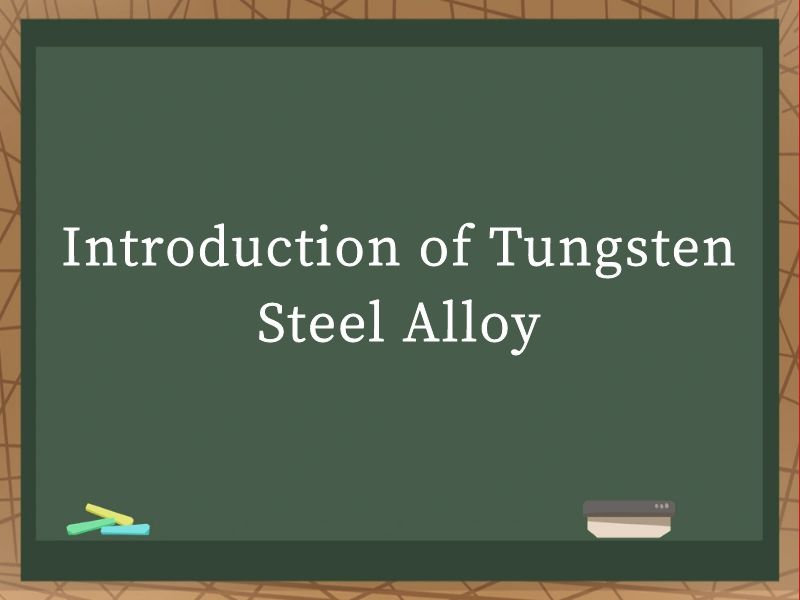JOURNALISM
- NEWS -
|
Introduction of Tungsten Steel AlloyIntroduction of Tungsten Steel Alloy.Tungsten steel alloy, a remarkable material known for its exceptional properties, has garnered significant attention in various industrial and technological applications. This alloy, primarily composed of tungsten (W) and other metallic elements such as carbon (C), cobalt (Co), chromium (Cr), and nickel (Ni), exhibits a unique combination of characteristics that make it indispensable in numerous fields. In this comprehensive introduction, we will delve into the composition, properties, manufacturing processes, applications, and future prospects of tungsten steel alloy.
Composition of Tungsten Steel Alloy Tungsten steel alloy primarily consists of tungsten, which is a rare metal with the highest density among all elements found naturally on Earth. Tungsten's high density, coupled with its exceptional hardness and strength, forms the backbone of this alloy's remarkable properties. Depending on the specific application, tungsten steel alloy may also contain varying percentages of carbon, cobalt, chromium, and nickel. Carbon is often added to enhance the hardness and wear resistance of the alloy. Cobalt, on the other hand, improves the alloy's ductility and machinability, allowing it to be shaped and worked more easily. Chromium and nickel contribute to the alloy's corrosion resistance and high-temperature stability, making it suitable for use in harsh environments. Properties of Tungsten Steel Alloy Tungsten steel alloy boasts a range of properties that set it apart from other metallic materials. Here are some of its most notable characteristics: Extreme Hardness and Wear Resistance: Tungsten steel alloy is renowned for its extremely high hardness, often exceeding that of conventional steel. This property, combined with its wear resistance, makes it ideal for applications where durability and longevity are crucial. High Density: With a density approaching or exceeding 17 g/cm³, tungsten steel alloy is one of the densest materials available. This high density contributes to its excellent machinability and ability to withstand high impact forces. Good Corrosion Resistance: The addition of chromium and nickel to tungsten steel alloy enhances its corrosion resistance, making it suitable for use in environments where exposure to corrosive substances is likely. High-Temperature Stability: Tungsten steel alloy maintains its mechanical properties and hardness at elevated temperatures, making it ideal for applications involving high heat. Good Electrical and Thermal Conductivity: Although not as conductive as some pure metals, tungsten steel alloy still possesses good electrical and thermal conductivity, making it useful in electrical and thermal applications. Manufacturing Processes of Tungsten Steel Alloy The manufacturing of tungsten steel alloy involves several complex processes to ensure the final product meets the required specifications. Here is an overview of the primary manufacturing steps: Raw Material Preparation: The raw materials, including tungsten powder, carbon powder, cobalt powder, chromium powder, and nickel powder, are carefully selected and mixed in precise proportions. Powder Metallurgy: The mixed powders are then consolidated using powder metallurgy techniques, such as sintering or hot pressing. During sintering, the powders are heated to a temperature below their melting point, causing them to fuse together and form a solid mass. Hot pressing applies pressure while heating, enhancing the density and strength of the resulting alloy. Heat Treatment: After consolidation, the alloy undergoes heat treatment to further enhance its mechanical properties. This may involve annealing, quenching, and tempering processes to optimize hardness, toughness, and ductility. Machining and Finishing: Once the alloy has been heat-treated, it is machined to the desired shape and size. This may involve milling, turning, grinding, or other precision machining techniques. The final step is finishing, which may include polishing, coating, or other surface treatments to improve the alloy's appearance and durability. Applications of Tungsten Steel Alloy Tungsten steel alloy's exceptional properties make it ideal for a wide range of applications across various industries. Here are some of the most notable uses: Cutting and Drilling Tools: Tungsten steel alloy is widely used in the manufacturing of cutting and drilling tools, such as drills, milling cutters, and turning tools. Its high hardness and wear resistance ensure that these tools can withstand the rigorous demands of metalworking and machining processes. Wear Parts: Components that are subject to high wear, such as bearings, gears, and valve seats, often benefit from the use of tungsten steel alloy. Its ability to maintain its shape and hardness even under heavy loads and high temperatures makes it an excellent choice for these applications. Medical Instruments: Tungsten steel alloy's corrosion resistance and biocompatibility make it suitable for use in medical instruments, such as surgical needles, dental drills, and other precision tools. Electrical Contacts: Due to its good electrical conductivity and high melting point, tungsten steel alloy is often used in electrical contacts and switches, particularly in high-voltage and high-current applications. Aerospace and Defense: In the aerospace and defense industries, tungsten steel alloy is used in components that require high density, hardness, and resistance to high temperatures and corrosion. Examples include rocket nozzles, missile casings, and armor plating. Jewelry and Watchmaking: Tungsten steel alloy's high density and scratch resistance make it an attractive material for jewelry and watchmaking. Its dark color and polished appearance add a sophisticated touch to watches, rings, and other accessories. Future Prospects of Tungsten Steel Alloy The future of tungsten steel alloy looks promising, with ongoing research and development efforts aimed at enhancing its properties and expanding its applications. Here are some trends and potential developments to watch: Advanced Manufacturing Techniques: As additive manufacturing (3D printing) and other advanced manufacturing techniques continue to evolve, they will likely be applied to tungsten steel alloy, enabling the production of more complex and customized components. New Alloy Developments: Researchers are constantly exploring new alloy compositions and processing methods to further improve tungsten steel alloy's properties. This may lead to the development of alloys with enhanced hardness, toughness, and corrosion resistance. Sustainable Manufacturing: The drive for sustainability in manufacturing will likely lead to the development of more environmentally friendly processes for producing tungsten steel alloy. This may involve recycling and reusing materials, reducing energy consumption, and minimizing waste. Interdisciplinary Applications: Tungsten steel alloy's unique properties make it an excellent candidate for interdisciplinary applications, such as in energy storage systems, sensors, and other emerging technologies. Tungsten steel alloy is a remarkable material with a wide range of applications across various industries. Its exceptional hardness, wear resistance, high density, and corrosion resistance make it an indispensable material in cutting and drilling tools, wear parts, medical instruments, electrical contacts, aerospace and defense, and jewelry and watchmaking. As research and development efforts continue, the future of tungsten steel alloy looks promising, with potential advancements in advanced manufacturing techniques, new alloy developments, sustainable manufacturing, and interdisciplinary applications. With its unique combination of properties, tungsten steel alloy is poised to remain a key material in the technological and industrial landscape for years to come. |


